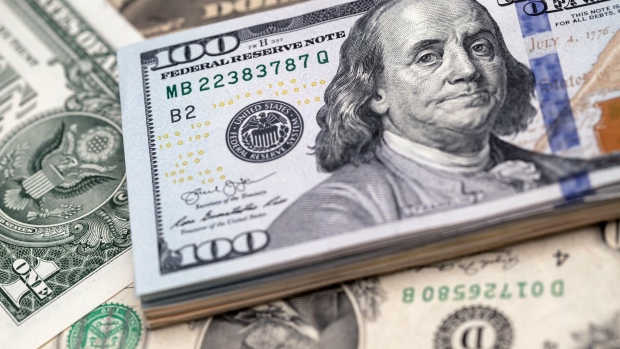Feb 5, 2024
Dollar Reaches Highest Since November as Traders Pare Fed Rate-Cut Bets
, Bloomberg News

(Bloomberg) -- The US dollar extended its rally as the resiliency of the world’s largest economy pushed traders to curtail the scale of expected interest-rate cuts.
The Bloomberg Dollar Spot Index rose as much as 0.6% on Monday to reach the highest level since Nov. 17, before curbing gains by the end of the day. The dollar has strengthened against all its major peers this year, with the Japanese yen weakening the most in a more than 5% drop.
Resilient macro data for the US, including a surprisingly strong jobs report last week, is pushing back expectations on the timing of the first rate reduction, while global forces ranging from China’s economic struggles to geopolitical uncertainties have boosted the dollar’s appeal as a safe haven.
“The dollar has a lot going for it right now, hard to be short,” said Brad Bechtel, global head of foreign exchange at Jefferies. “If the economy keeps putting up good numbers, the paradigm could change and we might need to re-evaluate the dollar from an even more bullish perspective.”
That economic strength and the prospect of rates staying elevated for longer has driven a rebound in the US currency from its December lows, when the Federal Reserve signaled that the central bank was preparing to pivot away from increases and weighing a series of cuts.
Fed officials cemented the end of their aggressive campaign to push up interest rates at the January meeting, but sought to reset expectations for how soon and how fast policymakers will cut this year as inflation pressures fade. Chair Jerome Powell said after the decision that a March rate cut was unlikely.
Read more: Powell Tells ‘60 Minutes’ Fed Is Wary of Cutting Rates Too Soon
With US rates still high and the Bank of Japan giving little clarity on when it will reverse its negative interest rate policy, the yen has been the worst performer in the Group of 10. The Japanese currency lost 0.3%, touching 148.89 for a dollar Monday.
Like Powell, euro-area policymakers are also pushing back on the near-term cut narrative. But bets that policymakers at the European Central Bank will lower borrowing costs before the Fed, perhaps as soon as April, are weighing on the euro, which fell as much as 0.6% Monday to trade at $1.0723, the lowest since Nov. 14.
Prospects of a wider interest-rate differential in favor of the US have been dragging the euro lower, by around 2.7% versus the dollar since the start of the year. Bechtel said the common currency could weaken further to $1.06.
Bearish bets on the euro remain hot following the currency’s busiest option day since July on Friday. Turnover on put contracts offering the right to sell the common currency in the future are outpacing call options by about a 3-to-1 ratio Monday.
“US dollar bulls have more reasons to cheer beyond the US exceptionalism and high carry stories,” wrote Charu Chanana, market strategist at Saxo Markets, in a Monday note. “A blowout nonfarm payrolls jobs report on Friday, together with Fed Chair Powell’s pushback to March rate cut expectations, will force the markets to re-assess its Fed expectations.”
--With assistance from Carter Johnson, Naomi Tajitsu and Robert Fullem.
(Updates market pricing, adds details throughout.)
©2024 Bloomberg L.P.






